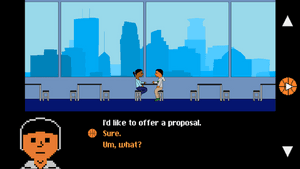Stay in the Loop
BSR publishes on a weekly schedule, with an email newsletter every Wednesday and Thursday morning. There’s no paywall, and subscribing is always free.
8-bit drama
'Watch Me Jump,' by Jeremy Gable: Theater as video game

Philadelphia is blessed with many talented playwrights, but the boom can go bust when the number of unproduced new plays meets limited resources. Jeremy Gable took an unusual tactic to get his as-yet-unproduced drama Watch Me Jump in front of audiences: he turned it into a video game.
Watch Me Jump tells the story of Audra Bee Mills, a rising star in the WNBA who faces a scandal the night before playoffs begin. Players go through the game as Audra, selecting what to say and do at certain intervals.
I’m a non-gamer and not very familiar with text-based narrative experiences online. But I experienced Watch Me Jump as a play in a different format and had a surprisingly good time.
Freedom of choice?
Although Watch Me Jump is ostensibly interactive, the choices feel pretty extraneous. Multiple plays of the game revealed that my decisions didn’t really affect what happened to Audra; often, different choices yielded exactly the same result.
As the Audra character, the player is often given the option to “explore” or interact with different objects, but only one choice leads somewhere. Audra responds to any other object with a line such as, “I don’t want to do that right now,” and players must choose the object that clearly moves the story forward. The result is that the game's rooms feel full of Chekhovian guns that are never used.
That the choices aren’t really choices is less frustrating than a potential player might imagine. Answering and deciding as Audra serves more to engage the player than to drive the story, and in that way, it’s successful.
Part of what makes Watch Me Jump work is that Gable brings all the rules of good playwriting to game design. He reveals information at just the right pace to keep the player motivated with questions, but never confused. Because all text appears on the screen, it’s forced to remain spare, and Gable avoids exposition, trusting the player to draw conclusions. He makes good use of punctuation to control the tone of conversations, particularly ellipses that appear one dot at a time.
Controlling the narrative
It’s good that Gable is so mindful of pace because the game format is unforgiving. In rare moments when the story slows down, it really drags. (For example, when Audra says a line, her manager asks “What?” — and Audra repeats the same line). That sort of interaction would be easy to ignore onstage, but the requirement that the player tap the character to move the dialogue forward makes any dip in pace glaring.
Although Gable wisely chose a play with a straightforward plot for his first experiment in turning a script into a game, he leaves plenty of issues worth considering. Watch Me Jump takes a new look at the old themes of sports and fame, and playing the game as a star athlete changes how a player might feel about her actions. The story places a black woman at its center, and four female characters largely drive the story. However, its one male character is still the most nuanced and easiest to identify with.
Designing Watch Me Jump gave Gable a level of control most playwrights can only fantasize about. He created the visuals and sound, working mostly on his own. As a result, the simple 8-bit graphics offer us a sense of what a play is like in the writer’s head, before a director and designers make the experience collaborative. Visuals and sound are indicated and left largely to the imagination, as when reading a novel.
From a theatrical perspective, Watch Me Jump’s success as an experience is bittersweet. It’s a shame more of Philly’s bounty of new plays can’t be produced as originally intended; it’s easy to empathize with the frustration that would drive a playwright to take control of the means of production. Still, experimenting with other media provides a practical way to get the work out there — and an enjoyable way to experience it.
What, When, Where
Watch Me Jump. Written and created by Jeremy Gable. $2.99 at iTunes and Google Play.
Sign up for our newsletter
All of the week's new articles, all in one place. Sign up for the free weekly BSR newsletters, and don't miss a conversation.
 Cara Blouin
Cara Blouin